2019 French Grand Prix - Preview
Milan, June 17, 2019 – The French Grand Prix at the Circuit Paul Ricard near Marseille is being run for only the second time since it re-appeared on the Formula 1 calendar last year. Pirelli will bring the C2 compound as the hard, C3 as the medium, and C4 as the soft tyre: the same nomination as Australia, China, and Azerbaijan. France, followed by Austria the next weekend, also marks the first of five back-to-back race pairings this year.
TRACK CHARACTERISTICS
- The circuit has been extensively resurfaced since last year, with nearly all of the corners – approximately a third of the lap – getting new asphalt. This is of similar specification to the existing asphalt, which should provide a consistent surface over the course of the entire lap.
- The asphalt is quite smooth, meaning that tyre degradation is generally low. The expected warm weather at this time of year in the south of France could lead to some thermal degradation though.
- The Circuit Paul Ricard is much more about lateral forces than traction and braking. This should make it easier to find the right balance between front and rear tyre temperatures – even though the long 1.8-kilometre Mistral straight (intersected by a chicane) can cool down the front tyres, and there are some heavy braking zones.
- Turn 13 at Paul Ricard has the second-highest continuous energy demands of the year, after Turn 1 in China.
- A one-stopper was the winning strategy last year, used by most competitors. The strategy in 2018 was influenced by an early safety car, which came out after the opening lap for five laps.
- At 5.8 kilometres in total, this is one of the longest laps of the year, with a number of overtaking opportunities.
MARIO ISOLA - HEAD OF F1 AND CAR RACING
“Our tyre choice this weekend is slightly more conservative than the 2018 soft, supersoft and ultrasoft tyres that we brought to France last year, as the supersoft is no longer part of the 2019 range. Consequently, the drivers should be able to push hard from the start to the finish of each stint. Along with Barcelona and Silverstone, we used the thinner gauge tyres in France last year, so we can again make a direct comparison about how the cars have evolved from 2018. Although a large part of the circuit has been re-asphalted, it should not make much difference to the track’s characteristics. With this being only the second time at the circuit, teams still do not have a full complement of data, so we will see plenty of learning. We have already used Paul Ricard for testing this year, but that has been on a much shorter, separate configuration rather than the full grand prix circuit”.
OTHER PIRELLI NEWS
- The French Grand Prix is another race where Pirelli is title sponsor, following straight on from the title sponsorship in Canada.
- Unlike recent races, the top three teams have made virtually identical tyre selections. The only exception is Red Bull’s Max Verstappen, who has chosen an extra set of mediums compared to his rivals. Generally speaking, the emphasis is on the red soft tyre.
- Formula 2 returns alongside Formula 3 in France this weekend. The first proper test of the 18-inch tyres for Formula 2 next year takes place this week in Spain, following a shakedown at Mugello last month.
| MIN. STARTING PRESSURES (slicks) | EOS CAMBER LIMIT | ||
|---|---|---|---|
 |
23.0 psi (front) | 20.0 psi (rear) | -3.50° (front) | -2.00° (rear) |  |
The tyres nominated this season
| Grand Prix | C1 | C2 | C3 | C4 | C5 |
|---|---|---|---|---|---|
| Australia | |||||
| Bahrain | |||||
| China | |||||
| Azerbaijan | |||||
| Spain | |||||
| Monaco | |||||
| Canada | |||||
| France | |||||
| Austria | |||||
| Great Britain | |||||
| Germany | |||||
| Hungary | |||||
| Singapore | |||||
| Russia |
























